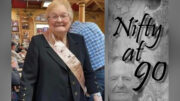Blatty died Thursday at a hospital in Bethesda, Maryland, where he lived, his widow, Julie Alicia Blatty, told The Associated Press. The cause of death was multiple myeloma, a form of blood cancer, she said.
Inspired by an incident in a Washington suburb that Blatty had read about while in college, “The Exorcist” was published in 1971, followed two years later by the film of the same name. Blatty’s story of a 12-year-old-girl inhabited by a satanic force spent more than a year on The New York Times fiction best-seller list and eventually sold more than 10 million copies. It reached a far wider audience through the movie version, directed by William Friedkin, produced and written by Blatty and starring Linda Blair as the young, bedeviled Regan.
“RIP William Peter Blatty, who wrote the great horror novel of our time,” Stephen King tweeted Friday. “So long, Old Bill.”
Even those who thought they had seen everything had never seen anything like the R-rated “The Exorcist” and its assault of vomit, blood, rotting teeth, ghastly eyes and whirlwind head-spinning — courtesy of makeup and special effects maestro Dick Smith. Fans didn’t care that Vincent Canby of The New York Times found it a “chunk of elegant occultist claptrap,” or that the set burned down during production. They stood for hours in freezing weather for the winter release and kept coming even as the movie, with its omnipresent soundtrack theme, Mike Oldfield’s chilly, tingly “Tubular Bells,” cast its own disturbing spell.
From around the world came reports of fainting, puking, epileptic fits, audience members charging the screen and waving rosary beads, and, in England, a boy committing murder and blaming “The Exorcist.” The Rev. Billy Graham would allege that the film’s very celluloid was evil.
“I was standing in the back of a theater in New York at the first public press screening of the film, too nervous to sit down,” Blatty told IGN.com in 2000. “And along came a woman who got up in about the fifth or sixth row. A young woman, who started walking up the aisle, slowly at first. She had her hand to her head. And then I could see her lips moving. She got close enough, and I could hear her murmuring, ‘Jesus, Jesus, Jesus.'”
Named the scariest movie of all time by Entertainment Weekly, “The Exorcist” topped $400 million worldwide at the box office, among the highest at the time for an R-rated picture. Oscar voters also offered rare respect for a horror film: “The Exorcist” was nominated for 10 Academy Awards and received two, for best sound and Blatty’s screenplay. Imitations, parodies and sequels were inevitable, whether the Leslie Nielsen spoof “Repossessed”; the four subsequent “Exorcist” movies (only one of which, “The Exorcist III,” involved Blatty) or a stage version performed in 2012 at the Geffen Playhouse in Los Angeles.
“When I was writing the novel I thought of it as a super-natural detective story, and to this day I cannot recall having a conscious intention to terrifying anybody, which you may take, I suppose, as an admission of failure on an almost stupefying scale,” Blatty told The Huffington Post in 2011.
Blatty returned to the “Exorcist” setting in “Legion,” which he adapted into “The Exorcist III.” He also revised a novel from the 1960s, “Twinkle, Twinkle, ‘Killer Kane”’; renamed it “The Ninth Configuration” and wrote and directed a 1980 film version that brought Blatty a Golden Globe for best screenplay. In 2011, he worked in a new scene for a reissue of the 1971 novel, originally acquired by Bantam Books for a reported $250,000. More recently, Fox announced it would revive the story as a TV series, starring Geena Davis.
Blatty was married four times and had eight children.
“He was an absolutely wonderful, kind, generous, faith-filled man, and I was very blessed to be his wife,” Julie Blatty said.
The son of Lebanese immigrants, Blatty was born in New York City and remembered a childhood of unpaid bills and nonstop evasion of rent collectors. He was a scholarship student at the Jesuit high school Brooklyn Preparatory (future Penn State football coach Joe Paterno was a year behind) and graduated as class valedictorian. He received another scholarship to attend Georgetown University and earned a master’s in English literature from George Washington University.
As recounted in his memoir “I’ll Tell Them I Remember You,” he took many detours on his journey to the top. He sold vacuum cleaners, drove a beer truck, served in the Air Force, was stationed in Beirut by the United States Information Agency, tried and failed to get stories published in Collier’s, and auditioned for a role in Cecil B. DeMille’s Biblical epic “The Ten Commandments.” He alleged that he was turned down because his eyes were blue.
For much of the 1960s, he turned out screenplays, including for the Blake Edwards films “A Shot in the Dark” and “What Did You Do In the War, Daddy?” By the end of the decade, he was in a state of “financial desperation” and finally got around to a novel he had been thinking about for years. He had remembered a Washington Post report from the late 1940s: A 14-year-old boy from Maryland was reportedly possessed, his condition defined by a visiting Duke University official as “the most impressive example of poltergeist phenomena I have ever come across.”
“Like so many Catholics, I’ve had so many little battles of wavering faith over the course of my life,” Blatty, who would allege numerous mysterious events while working on the book, told IGN.com.
“And when I heard about this case and read the details, that seemed so compelling. I thought, ‘My God, if someone were to investigate this and authenticate it, what a tremendous boost to faith it would be.’ I thought, ‘Someday I would like to see that happen. You know, I would like to do it.'”






































